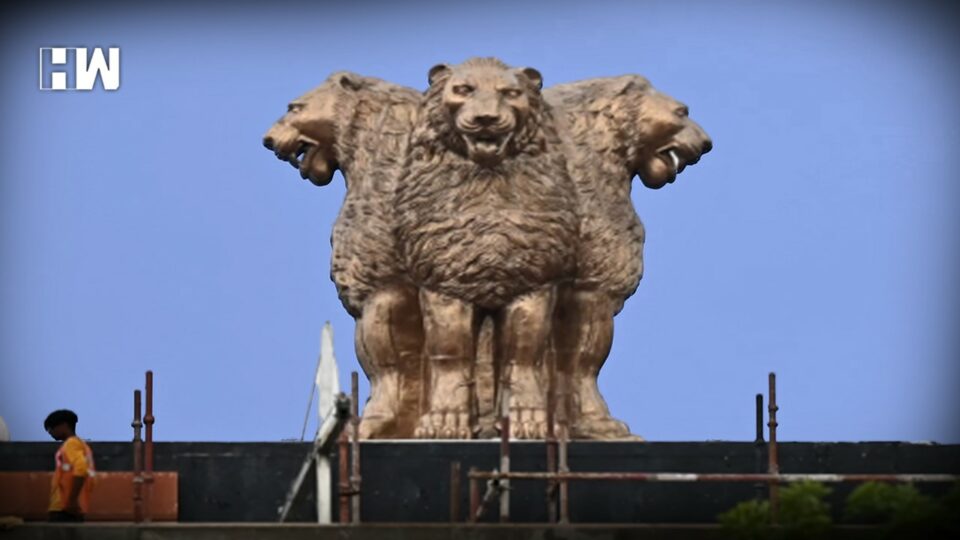Our honorable Prime Minister Narendra Modi recently unveiled the national emblem cast on the roof of the new parliament building that led to a splurge of critical observation and remarks from different quarters of socio- political and cultural sphere. A glance at the image of newly unveiled national emblem raises several doubts and contentions. The very immediate notice of the appearance of the lions itself commence the points of contention.
National emblem of a nation resonates her identity and value system. In a global world order a national emblem of a nation represents the message it holds for the world. In a way the national emblem can also be viewed as the lens to glance the true imagery of a nation from the vantage point of imbibed philosophical values. It is therefore needless to emphasis how important is national emblem in shaping the appropriate context of nation’s foreign policy, diplomatic relations and most importantly asserting of its national interest.
India’s national emblem is an adaptation from the Sarnath Lion Capital of Ashoka. In the original, there are four lions, standing back to back, mounted on an abacus with a frieze carrying sculptures in high relief of an elephant, a galloping horse, a bull and a lion separated by intervening wheels over a bell-shaped lotus. Carved out of a single block of polished sandstone, the capital is crowned by the Wheel of the Law (Dharma Chakra). In the State Emblem, adopted by the Government of India on 26 January 1950, only three lions are visible, the fourth being hidden from view. The wheel appears in relief in the centre of the abacus with a bull on right and a horse on left and the outlines of other wheels on extreme right and left. The bell-shaped lotus has been omitted. The words Satyameva Jayate from Mundaka Upanishad, meaning ‘Truth Alone Triumphs’, are inscribed below the abacus in Devanagari script. India’s national emblem symbolizes the true meaning of India, and for the message of the Indian State. Our judicial institutions and law enforcing institution (Indian Police, CBI, ED, IT) display the national emblem as marker integrity, impartiality and allegiance to constitutional provision. Through emblem our coin and currency notes assure legitimacy.
A sudden modification and installation of the national emblem on the top of parliament building without any discussion in the parliament or state assemblies and without taking any consolidated public opinion, raises several apprehensions on the intent. The importance of intent is very crucial in an executive decision that is taken in political sphere as contemporary politics is filled with instances of judging the intent behind a particular decision. A calm, confident, reassuring and protecting lions have been replaced by appearing to be fierce and menacing set of lions gazing from the top new parliament building. Everything about the inaugural ceremony appeared to be contentious from the unilateral change in the national emblem to the absence of President of India who is head of the parliament, vice president of India who is the presiding officer of Rajya Sabha and leader of Opposition and one can just go on with the list. Prayers of only one religion consecrating a ceremony of a religiously impartial Indian state, should put most devout citizens to introspect where we as secular, republican constitutional democracy heading. Many from the ruling dispensation are writing off these critical observations as a matter of perception but unfortunately those making such counter observation should remember that a state is perceived as based on a larger perception it creates for itself in the changing global order. Many from the socio-political, cultural, and literary field addressing this concern as a trivial matter to be overlooked but today what may look trivial to most of the intelligentsia may turn out to be symbol of disaster in the fasting changing global world order. This is the reason our nation needs to reassure by all means possible that our legacy of our national symbols in all forms needs to be protected and emphasized in best capacities through different mediums. Any attempt to disregard, distort these symbols of highest stature under the garb of terms like ‘perception’ can prove to be detrimental to the growth and progress of a nation.
The Author is an Assistant Professor of Political Science at Shoolini University, Solan, Himachal Pradesh.
(Views Expressed Are Personal)
As an independent media platform, we do not take advertisements from governments and corporate houses. It is you, our readers, who have supported us on our journey to do honest and unbiased journalism. Please contribute, so that we can continue to do the same in future.

